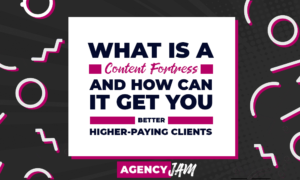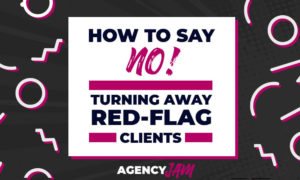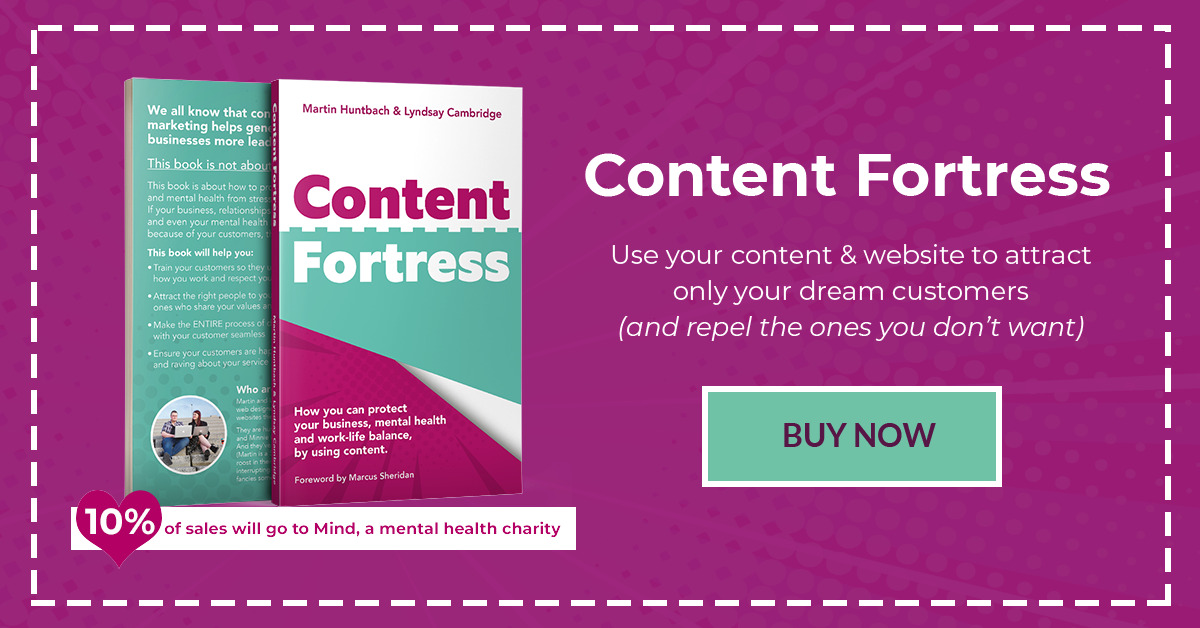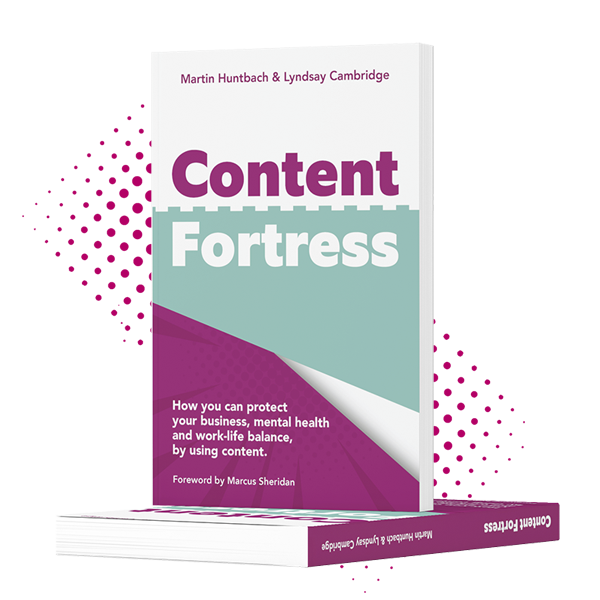How to Compete with Bigger Agencies in 4 Easy Steps

Everyone loves a good underdog story.
Luke Skywalker vs Darth Vader
Katniss Everdeen vs President Snow
Tyrion Lannister vs well, pretty much his entire family
However, this is fiction, right?
When it comes to us little guys and gals, it’s difficult to think that we can go up against some huge agencies.
You know the ones – they have a massive team. And a swanky office. And on their website, they proudly display the logos of some pretty impressive companies they’ve worked with.
In reality, it can be a little less ‘hero prevails’ and a little more ‘hero second-guesses themselves, suffers imposter syndrome and consistently undercharges for their work’ – we know, we’ve been there (still feel it too).
But Can You Really Attract the Companies that Would Ordinarily Use a Large Agency?
In short, yes, you can.
We certainly did. We’re not freelancers (we’re a two-man band) but we weren’t the typical type of company that large organisations would approach for their web design. We worked from home with our toddler and cats. We didn’t wear fancy suits. We didn’t have a swish office.
But yes, we managed to attract larger businesses that wouldn’t typically approach us. Businesses with a million pound + turnover, that would usually seek the help of a big, fancy agency.
And many other smaller agencies and personal brands are doing the same. They are attracting bigger businesses. And the benefits are clear, bigger businesses = bigger budgets. We also found that they were more interested in website strategy (our personal favourite topic) so we had the opportunity to explore that with them.
In short, we got paid more and got more enjoyment from the work. It’s easy to see why lots of freelancers and smaller agency owners would want to attract bigger clients.
So, how can you land these bigger companies with bigger budgets? How can you compete with larger digital agencies?
To Compete With Larger Agencies, You Need to Forget About Competing
Here’s the thing: as a freelancer or small agency, you can’t compete with larger agencies on their level.
We’ve seen freelancers try to appear ‘bigger than they are’. They say ‘we’ instead of ‘I’. They use corporate office images on their websites (even though they work from home).
We once spoke to a web designer who’d created email accounts with fake names and job titles just so they appeared ‘bigger’.
If you do this, you won’t win.
You can’t take the strengths of a huge agency (the size of their team, their impressive portfolio, the fancy office, their name and prestige, etc) and compete with that.
You need to tackle their weaknesses.
And you need to take the experiences of the clients who’ve worked with large agencies, and state what you, as a freelancer or small agency, can do better.
And then you need to shout about it. From the actual rooftops!
And luckily for you, here are our exact steps to do this.
Step One: Lean into the Problems with Big Agencies
You first need to look at the problems people may have with larger agencies.
Now, it’s worth mentioning at this point that there are lots of larger agencies out there who are great at what they do and care about their customers (and of course there are some crap ones too).
This is not about bashing specific agencies, or worse, making things up (like all larger agencies are out to rip off their clients, for example). It’s about highlighting some of the common issues people may have with bigger agencies.
In our experience, clients who would’ve ordinarily worked with a large agency came to us instead because they’d experienced the following:
- The agency insisted that they use a custom-built CMS that no other agency was familiar with – they were therefore reliant on them to make changes and couldn’t move to another agency
- They didn’t get access to their website, and instead, they had to pay large fees to make changes
- They often struggled to speak to the person in charge (and had to go through multiple people)
- They had to wait days or even weeks for small changes (and they didn’t have the ability to do this themselves)
- The larger agencies used a lot of jargon
- They didn’t feel like the agency cared about their project and felt like ‘just another number.’
We began to see a pattern and understood why some companies would approach us instead of big web design agencies. Essentially, we were different. After years (or even decades) of the same experiences, some companies were prepared to invest in us instead.
Step Two: Create Content that Explores the Weaknesses of Other Agencies
Once you come to understand the problems your potential clients have with other companies, you can start to attract them to you.
The question is how?
This is why we created content like:
- How to Avoid Hiring a Bad Web Design Agency
- 4 Ways to Find Web Designers to Work With
- Problems that Occur When You Get a New Website… and how we prevent them
- 5 Common Problems with Web Design Companies
This kind of content helps those who’ve had problems with their previous agencies or who are wanting to avoid problems in the future (or both). It’s only when we started to talk about it, did larger companies pay attention to us.
We captured them in the ‘research phase’ of their website redesign. When they were looking for ways to avoid all the problems they’d had before. They stumbled across these articles, signed up to our email list and we started to get their attention.
Step Three: Ask yourself the Best Question: Why Would Someone Not Work With You?
This is quite possibly the best question you can ask yourself: why would someone NOT work with you?
If you’re wanting to attract businesses that would ordinarily work with big agencies, then it’s not enough to just talk about the problems with big agencies. You also need to explain why you’re potentially a better option.
Even though people may have had bad experiences with larger agencies in the past, it’s not that easy to get someone to change the way they’ve always done things. If their competitors use large, impressive agencies and they’ve always used large, impressive agencies, convincing them that little ole you can do just as well (and better) is going to take some work.
As much as you may not like it, bigger businesses may have some preconceived notions about working with you – especially if you’re a small team or freelancer. You need to figure out what these objections are.
They could be thinking…
- I’m not sure you’ll be able to handle the size of the project
- Why are you charging me the same amount as a large agency would, even though you’re a freelancer?
- Will I get the same level of customer service from you as I would a larger agency?
- Will my website be secure?
- Why do your prices vary so drastically? Are you just charging me more because I’m a bigger company?
- What if you get hit by a bus? (yes, an actual question we’ve been asked before!)
Step Four: Create Content that Tackles these Objections
Once you’ve figured out why larger companies would not want to work with you, it’s time to start creating content that tackles those objections.
We like to call this ‘Attracting Content’. Attracting content is content that attracts your dream clients, even if they’ve never considered you before OR they think you’re not right for them. It comes from our book, Content Fortress.
Instead of avoiding these objections, you need to lean into them. You need to voice them out loud (so your target audience feels heard and understood) AND explain why they might be wrong. It’s all about putting your target audience at ease.
That’s why we created the following content when offered web design.
We’ve always been open about our web design prices (starting from 5K+) but when larger companies approached us, we charged way more than 5K.
Our pricing page stated from 5K, and a prospect who ran a large company questioned why we were charging them significantly more than that.
So we published a piece of content about why. And sent it to this prospect (along with every other future prospect who got in touch).
They went ahead with us. And one of the reasons why is because we identified this objection and published content around it.
Because, people don’t care what you say, they care what you publish.
We could’ve easily explained to this prospect over a call why we charged larger businesses more. But unfortunately, talk is cheap. Only once you publish something for everyone to see does it become trusted.
A lot of big businesses request that agencies and freelancers ‘pitch’ for work. They then evaluate which company they liked best and select one.
We don’t pitch. Mainly because it’s a massive time-suck and you’re expected to give away all your ideas for free.
But for large businesses, this was a real turn-off. They didn’t like the fact that we refused to pitch.
So…(and I think you’ll guess what’s coming now) we wrote a blog post about why we don’t pitch. And we send it to everyone who requests a pitch from us. We’ve landed a lot of bigger clients from this simple blog post, and without having to pitch!
Those are just two examples of content that handles people’s objections. So next time you hear that slight unease from your prospect, make a note of it and turn it into content.
Step 5: Build your Personal Brand
Creating content is one thing. But you’re going to want to build your personal brand at the same time.
You can’t go up against bigger, swankier agencies if your brand and website look like a carbon copy of everyone else.
This is why you have to put yourself out there. You have to become recognisable.
This, of course, takes time. And it develops over months and years. You form your own voice, your own style, your own way of doing things. That’s all unique to you and what you offer. If you want to learn more about personal branding for agencies, check out this fab blog post from Nicole Osborne: Five Inspirational Personal Branding Examples from Agency Owners Across the Globe.
But remember, the first step is getting your face out there. When people consume your content they must see you – even if it’s written content like this. Make sure you have images of yourself on your website. If you’re writing blog posts, make sure the writing comes across like you’re chatting to a friend. Don’t use jargon or make someone feel small.
And Remember, Your USP Isn’t What You Think It Is…
Are we the best web designers in the world? Nope.
Are we the only ones who can do what we can do? Nope.
Are we the only people who can help other agencies with content marketing? Nope.
I could go on.
The point is, even though what you do is amazing. Even though you offer excellent customer service and an amazing website, it doesn’t mean that others can’t do that either. The ‘U’ is your USP isn’t that you’re amazing at design, or that your websites are super-duper fast. Because even though these things are important, they’re not unique to you.
The one thing that makes you different from others is you.
And if you don’t create content and build your brand, you’re unlikely to attract larger businesses.
Remember the One Key Takeaway!
If there’s one thing you should do right now is ask yourself this question…
Why would someone not work with you?
Think about the answers, write them down and turn them into content!
And if you want to know more about how to create content that attracts better, higher-paying customers, check out the Content Fortress course.
The price of the course will increase on Wednesday 30 June to $500.00. Currently, the price is $247.00.
Want some more?
Of course you do. Check out these articles...

What is a Content Fortress and how can it help your agency get better, higher-paying clients?

Why Every Agency Needs to Create ‘Sales Content’ (and how to do it)


How to Use Content to Transform Prospects into Your Dream Clients



